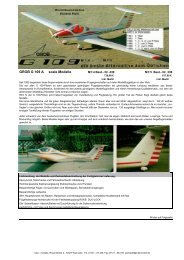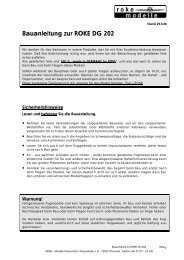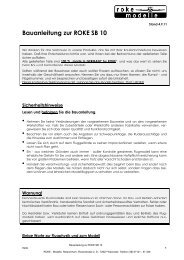Bedienungsanleitung Graupner JR mx-12 (englische Version) - ROKE
Bedienungsanleitung Graupner JR mx-12 (englische Version) - ROKE
Bedienungsanleitung Graupner JR mx-12 (englische Version) - ROKE
Create successful ePaper yourself
Turn your PDF publications into a flip-book with our unique Google optimized e-Paper software.
Function mode HELICOPTER<br />
Revolution Mixing (Non-heading lock Gyros only), Programmable Mixing (1~2)<br />
Revolution Mixing (Non-heading lock Gyros only)<br />
The Revolution Mixing function mixes tail rotor with the<br />
Throttle and Pitch Curve functions to counteract torque<br />
from the main rotor blades. When set up correctly, the<br />
helicopter should climb and descend without a tendency<br />
to yaw in either direction. Because torque reaction varies<br />
with different power settings, it is necessary to vary<br />
the tail rotor pitch at the same time. The <strong>mx</strong>-<strong>12</strong> offers<br />
two separate revolution mixing programs, with independent<br />
up and down mixing for each - one for Flight mode<br />
position Normal and the other for Stunt. The up mixing<br />
adjusts the tail rotor compensation for the mid to high<br />
throttle setting and the down mixing adjusts the tail rotor<br />
compensation for the mid to low throttle setting.<br />
Mixing Value (L<strong>12</strong>5%~0~R<strong>12</strong>5%)<br />
Mixing Program<br />
NORMAL STUNT<br />
UP: Up side UP: Up side<br />
DN: Down side DN: Down side<br />
Go to Programmable<br />
Mixing menu<br />
Go to Pitch curve<br />
menu<br />
Highlight function to<br />
change<br />
Change value/<br />
Switch selection<br />
Reset selection to<br />
default<br />
Accessing the Revolution Mixing Function<br />
1. Place the transmitter power switch in the ON positi-<br />
on.<br />
2. Press the Down and Select keys simultaneously<br />
to enter the Function Mode.<br />
3. Press the Up or Down keys until REVO MX ap-<br />
pears at the top of the LCD.<br />
4. Pressing the Select key will highlight either the Up<br />
mix, Down mix, or the flight mode switch position.<br />
When the flight mode switch is in the displayed<br />
position and the throttle stick is in the displayed<br />
position, the flight mode will be underlined.<br />
5. Press the (+) key to increase the right tail compen-<br />
sation or press the (-) key to increase the left com-<br />
pensation. Press the Clear to reset to 0%.<br />
6. This setup procedure can be used for revolution<br />
mixing for either flight mode switch position Normal<br />
or Stunt. The Stunt position should be used for<br />
forward and/or inverted compensation.<br />
7. Access the PITCH CURVE function by pressing the<br />
Down key.<br />
8. Access the MX1 function by pressing the Up key.<br />
9. Exit the REVO MX function by pressing the Down<br />
and Select keys simultaneously.<br />
Setting Up Revolution Mixing (non-heading lock,<br />
gyros only)<br />
Set up the helicopter so that it will hover with the tail<br />
rotor trim entered. Establish the helicopter into a stable<br />
hover, then steadily increase the throttle to initiate a<br />
steady climb. The body of the helicopter will move in the<br />
opposite direction to the main rotor rotation. Increase<br />
the U, Up, setting until the helicopter climbs with no<br />
tendency to turn. At a safe altitude, close the throttle;<br />
the helicopter will same direction as the main rotor rotation.<br />
Increase the D, or Down, mix until the helicopter<br />
descends with no tendency to turn. Throttle stick movements<br />
should be slow, and the initial accerlation and<br />
deceleration swings should be ignored. The Accerlation<br />
Mixing function is provided to compensate for the main<br />
rotor accerlation (and decerlation) torque.<br />
Programmable Mixing (1~2)<br />
The <strong>mx</strong>-<strong>12</strong> offers two programmable mixes to be used<br />
for any number of different purposes. This function allows<br />
mixing any one channel to any other channel. This<br />
mix can remain on at all times or be switched on and off<br />
in flight using a number or different switches.<br />
Mix number 1 is of the standard variety, in that the digital<br />
trim for the master channel only affect the master channel,<br />
and not the slave channel. Mix number 2 is of the<br />
“Trim include“ variety. This mix is used any time the mix<br />
requires the slave channels trim position to be varied<br />
when the master channels digital trim position is varied.<br />
Each channel of this radio is identified by an abbreviated<br />
name. The chart below indicates the channel ant its corresponding<br />
abbreviation. The channel name appearing<br />
first is known as the “master channel“ or the channel to<br />
which you want to mix. The second number is known<br />
as the “slave channel“ or the channel that is beeing<br />
mixed into the master-channel. For example, AILRUD<br />
would indicate aileron-to-rudder mixing. Each time the<br />
aileron stick is moved, the aileron will deflect, and the<br />
rudder will automatically move in the direction and to<br />
the value input. Mixing is proportional, so small inputs<br />
of the master channel will produce small outputs of the<br />
slave channel. Each programmable mix has a mixing<br />
“offset“. The purpose of the mixing offset is to redefine<br />
the neutral position of the slave channel.<br />
Mix percentages<br />
(+/- <strong>12</strong>5%)<br />
Slave Channel<br />
Master Channel<br />
Mix SW selection<br />
Offset value<br />
(+/- <strong>12</strong>5)<br />
Function mode HELICOPTER 33








